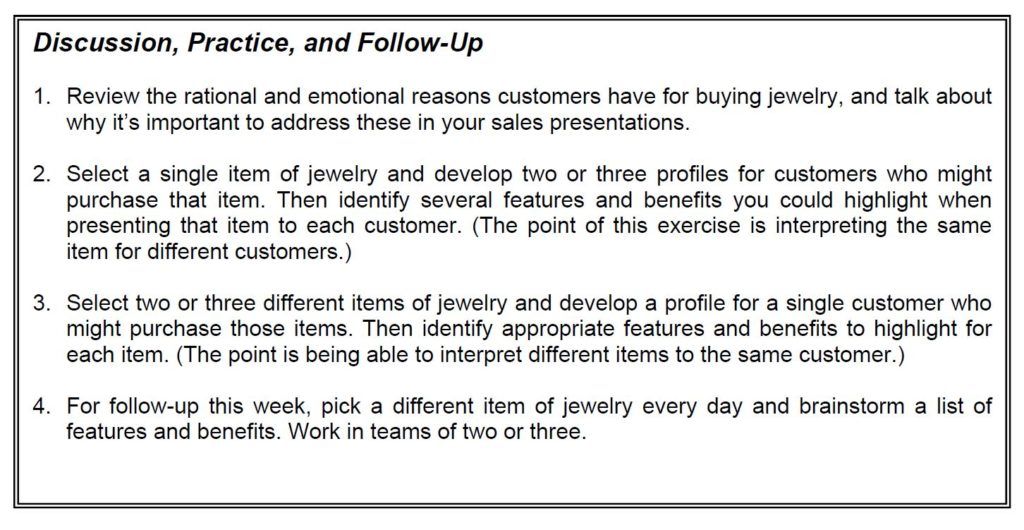Presenting Features and Benefits
Article provided for The Plumb Club by Kate Peterson, PC Performance Concepts 
When you present jewelry, you’re not just selling a product.
You’re also selling the benefits of owning or giving that product. So, in sales presentations you need to be able to translate jewelry and its features into benefits that are meaningful to your customers.
A feature is basically a fact about a jewelry item. Some features can be measured or judged objectively. Examples include the 4Cs of diamond value and the fineness of the gold, platinum, or silver from which a ring is made. Others—like the fashion appeal of a particular color or the artistry of a design—are hard to quantify precisely, even though they’re definitely there.

Kate Peterson
A benefit, on the other hand, is something positive a feature means or does for a particular customer. It somehow fulfills psychological or emotional needs that the customer has for making the purchase, and when you state a benefit, you’re essentially saying, “If you buy this, you get this.”
Explaining how features work to the customer’s advantage is critical. If you can identify features, but can’t match them with significant benefits, you’re not answering the key customer question: “What’s in it for me?”
That a diamond has high clarity, fine color, and excellent cut might seem like a great reason to buy it. But if the customer is mainly interested in what the diamond will say about his feelings to the woman he loves, or his success to her friends, the bare facts probably won’t be enough. You need to interpret those facts in a way that addresses the real reasons for making the purchase. That takes identifying the customer’s motives during the
profiling phase of the selling process, and then linking features to appropriate benefits when you present your merchandise.
People usually buy jewelry for a combination of rational and emotional reasons. Rational reasons include lasting value, dependability, convenience, durability, versatility, and affordability. Examples of emotional reasons are romance, social status, fashion, achievement, love of beauty, and pride of
possession.
A single feature can provide a number of different benefits. For instance, you could link high quality in a diamond to more than half the motives we just mentioned. But that doesn’t mean you can simply throw out a bunch of possibilities and hope some of them stick. You’ve got to do your best to target each customer’s motives with pinpoint precision.
As you’re presenting merchandise, try to gauge the customer’s reaction every time you state a feature-benefit combination. Be alert for both verbal and nonverbal clues. If you receive a positive response, keep moving in that direction. If not, stop, back up, do a little more profiling, and then try another approach.
You can link features and benefits with the word “so.” In other words, state the feature and follow it with “so you have,” “so you know,” “so you get,” and so forth. For example:
- This diamond’s high clarity and color grades make it very rare, so you know it sends the right message about your feelings.
- This ring has a Tiffany-style setting, so it makes the diamond stand out in all its brilliance and fire.
- This pink sapphire has excellent wearability, so you have a uniquely feminine color in a gem that’s tough enough to enjoy for a lifetime.”
- This bracelet has a double safety clasp, so you can wear it without worrying about so you losing it.
Of course, the benefits that speak to one customer may be completely meaningless to another. As a result, you must know all the facts—or features—about the jewelry you present. But you must also be prepared with an ample list of corresponding benefits from which to choose. This will allow you to tailor your presentations to different customers.
You might say this aspect of the selling process comes down to a fast-moving interplay interplay in which you take features and benefits you’re familiar with, and match them up with individual needs, wants, and desires you’re just discovering. Consider it a challenge, and enjoy the game!
